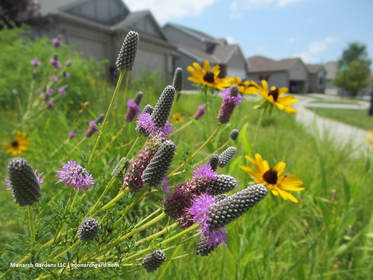Choosing the right plant for the right place is how one gardens successfully -- every time. Changing the site to fit what you want to grow is like trying to change your spouse to be the perfect mate... in the end, you'll have wasted a lot of time and energy while you'll eventually give up on the relationship altogether. So fall in love with clay soil.
Clay has the smallest particle size of soil ingredients, which include sand and silt. It has a very high water-holding ability, and is a fantastic nutrient holder, as well. A lot of our clay soils organize themselves in layers or fine sheets that are negatively charged; plant nutrients are positively charged, and so are attracted to the the soil levels and "stick" like opposite ends of a magnet. This is why clay soil is often a very rich soil to work in, even though we'd assume that's not the case.
Take pale purple coneflower, Echinacea pallida, a mainstay in prairie garden design. It's deep taproot is designed to punch through clay soil, which also makes it pretty drought tolerant. When you put it in a loamy bed this coneflower grows too fast, gets too tall, flops over, and has a much shorter lifespan. Why? You gave it a far too rich soil and it went bonkers. It's not evolved for that kind of soil. And now you have more maintenance because you've got to replace the plant. Many prairie forbs like pale purple coneflower have evolved these strong taproots for a purpose, just as the more fibrous roots of grasses and sedges. Together, all these plants reach into clay soil and slowly amend it naturally, adding nutrients while opening up spaces for water and air to penetrate. In fact, up to 1/3 of prairie grass roots die each year, and as they decompose they enrich the soil. This is why farming is so successful in the upper Midwest and eastern Plains.
So love your clay. If it's too hard to dig into, try using smaller 3" pots or plugs instead of massive and pricey one gallon pots. Consider a mix of sowing grasses and forbs with some potted plants. I like to create designs with forbs then come in and sow a groundcover of grasses -- which speeds up planting, saves my back, and costs less (plus that means no wood mulch). You could also sow a cover crop of annual native grasses and forbs, even biennial forbs like Rudbeckia hirta (black-eyed susan) and Ratibida columnifera (mexican hat coneflower), to help prep the soil for a year or two. Otherwise, at planting time, a thin layer of 1/2" to 1" of compost doesn't hurt to add some organic matter if tests show the soil could use some.
When I meet a client who drops their head in their landscape sighing "I have clay soil, I know there isn't much we can do," I love to smile and say, "actually, because you have clay, we can do so much more."
Say it with me. Love your clay. Plant for it, not against it. Use nature to your advantage. Learn to be one with the force.
To learn more about sustainable wildlife gardening, check out some 200 articles or try one of these 15 online classes.



 RSS Feed
RSS Feed

